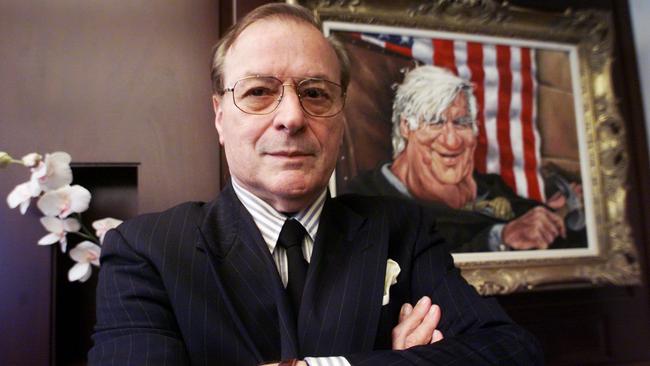War hero Ranan Lurie left the trenches to be an acclaimed cartoonist
Ranan Lurie’s withering cartoons and remarkable caricatures were published the world over – but he was a soldier at heart.

Ranan Lurie Political cartoonist.
Born Port Said, Egypt, May 26, 1932; died Las Vegas, June 8, aged 90.
-
In 1982, a journalist from London’s The Sun newspaper aboard HMS Invincible painted “Up yours Galtieri” on a missile that later was reported to have brought down one of Argentinian dictator General Leopoldo Galtieri’s jets during the Falklands War. Hand-wringers on the left thought this scandalous.
Turns out the Sun man wasn’t first. In 1948 an ambitious air cadet in the new Israeli air force was at 8000ft in a transport aircraft that had been fitted out as a crude bomber. Before readying a 5kg bomb he was about to “hurl” at Egyptian forces in the Gaza Strip, he drew on it “From the producer to the consumer”.
Ranan Lurie would go on to become the world’s most famous cartoonist, whose work would appear in some of the most esteemed mastheads: Tel Aviv’s Yedioth Ahronoth, The Times, Die Welt, Asahi Shimbun, Newsweek, Time, Le Figaro and The New York Times where, for years, he illustrated a regular column with former Soviet leader Mikhail Gorbachev. At one stage he was syndicated to more than 1000 publications.
While he always sought peace in his cartoons – and was once nominated for a Nobel Peace Prize – he was willing to fight for liberal democracy. He was sacked from the air force when, while training, he flew so low over a beach in Tel Aviv that lifesavers leapt from their paddleboards. He went on to become a major with the Israeli Defence Force reservists.
Lurie was overseeing his long-planned fine-art exhibition at the 1967 Montreal Expo when tensions between Israel and its hostile Arab neighbours boiled over and war seemed imminent. He returned to duty with his comrades in the Fifth Brigade. With tanks, Jeeps and howitzers they defended that narrowest neck of land in the middle of Israel between the sea and Tulkarm, just 14k to the west. Despite the chaos of the Arab attacks, they came under heavy fire, but resisted it and pushed on to Nablus, 35km into Jordan.
That month he wrote a long piece for Life magazine under the headline “A Major’s Long Ride to a Short War” and was invited to join the staff in New York.
Israelis were already aware that Lurie was uncommonly brave. In 1954 he had posed as an Australian reporter to get aboard an Egyptian warship moored off Italy in the Adriatic Sea and while aboard he spoke to senior officers and surreptitiously photographed its top-secret Russian-supplied anti-aircraft weapons system – photographs and details of which he published in the IDF’s own journal.
Lurie had been born in Egypt after his parents travelled there to stay with his grandfather, a rabbi who sold wines from the Carmel vineyards south of Tel Aviv, where one of the workers was David Ben-Gurion, later to be the first prime minister of Israel. The Lurie family is among Jerusalem’s most ancient and claims to be able to trace its lineage back to the Prophet Isaiah. They are related to German composer Felix Mendelssohn and the founder of psychoanalysis, Austrian doctor Sigmund Freud.
“I was always good at drawing, even at age four,” Lurie told a reporter, describing his early life in Jerusalem. As a teenager he joined a Zionist underground paramilitary and was wounded by a hand grenade. While recovering in hospital he began to draw cartoons. By 16 he had some published. Soon he was the regular cartoonist in the country’s biggest selling newspaper. He was not a religious man, but he suggested it was a superior being that guided him towards his profession. “I believe that we were created for a purpose,” he told an interviewer 13 years ago. “To create things from nothing, to add your value to history. The fact is, we remember Rembrandt, but we do not remember the man who made the frames for his pictures.”
He would approach world leaders – and often they sought him out – to draw their caricatures. Subjects he drew face-to-face include UN secretary general Kofi Annan, Israeli prime minister Ehud Barak, Egyptian leader Anwar Sadat, US presidents Ronald Reagan, Gerald Ford and Barack Obama and even Palestinian leader Yasser Arafat – most with penetrating abstraction.
He believed caricatures were more powerful than any photographs. He told a reporter in 2017 that “even if it is the most sophisticated camera in the world, it will never be able to capture the person more accurately than the artist or the cartoonist who knows how to point out his true character”.




To join the conversation, please log in. Don't have an account? Register
Join the conversation, you are commenting as Logout